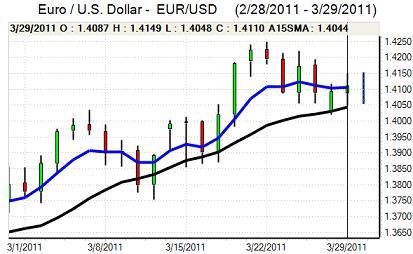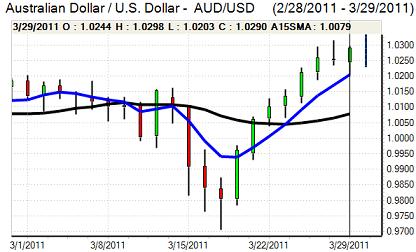EUR/USD
The Euro hit resistance close to 1.4150 against the dollar during Tuesday and dipped to test support in the 1.4050 area, but markets were unable to make a decisive attack on technical levels as the Euro remained resilient while the dollar weakened against commodity currencies.
The US consumer confidence data was slightly weaker than expected with a decline to 63.4 for March from a revised 72.0 previously while the Case-Shiller house-price index registered a 3.1% decline in the year to February.
The data impact was limited as markets focussed on Federal Reserve comments and the possibility that the quantitative easing programme will be ended early. Following comments over the weekend, Regional Fed President Bullard stated that the bond-buying programme could be reduced by US$100bn to US$500bn given the stronger economy. Although not an FOMC voting member this year, Bullard worked closely with Chairman Bernanke last year and there will be speculation that his more hawkish tone is also a subtle indicator of a change in thinking within the FOMC. There was a renewed increase in US Treasury yields which provided some dollar support.
Within Europe, Standard & Poor’s downgraded Portugal’s credit rating again and warned of further action over peripheral ratings over the next few weeks. Markets continued to expect an imminent move by Portugal to ask for EU support and underlying confidence remained extremely fragile, especially with fears that Spanish savings banks would require additional support.
ECB officials maintained a tough tone on inflation and remained firmly on track for an interest rate increase at the April meeting. There was also some market speculation that the central bank could decide on a 0.50% increase which contributed to the Euro’s resilience.

Source: VantagePoint Intermarket Analysis Software
Call now and you will be provided with FREE recent forecasts
that are up to 86% accurate * 800-732-5407
If you would rather have the recent forecasts sent to you, please go here
Yen
The dollar moved to challenge resistance levels near 82 against the yen during Tuesday, the strongest US level since the G7 March intervention, and a break above this level triggered heavy US currency buying which took it to a peak around the 82.40 level during New York trading.
Yield considerations remained important with the US benchmark 10-year yields rising back above the 3.50% level on additional speculation over an early ending to quantitative easing and there was a direct negative yen impact.
Capital repatriation flows also slowed which lessened support for the Japanese currency. Industrial production rose 0.4% for February, but the impact was minimal given that production will dip sharply in the near term. There were suggestions that an initial extra budget could be in the region of JP2trn and the fiscal position remains perilous. The yen weakened further to lows near 83.0 during Asian trading on Wednesday.
Sterling
Sterling was unable to make a move back above 1.6040 against the dollar during Tuesday and weakened to retest support below 1.5950 before finding fresh buying support as ranges narrowed.
Fourth-quarter GDP data was revised to -0.5% from -0.6% previously while there was also some improvement in bank lending and mortgage approvals. The current account deficit for the fourth quarter widened to GBP10.5bn from GBP8.7bn previously as the goods deficit widened to an all-time high. The data overall continued to suggest a very fragile economy, but also indicated the possibility that credit conditions were easier.
The series of PMI business confidence readings starting on Friday will be very important for sentiment and near-term Bank of England policy intentions. In comments on Tuesday, MPC member Weale maintained his call for an early increase in rates to stem inflation which provided some Sterling support.
Swiss franc
The dollar found support just below the 0.9150 level against the franc during Tuesday and rallied to a high above 0.9230 in Asian trading on Wednesday as the Swiss currency lost ground on the crosses. The franc has found it more difficult to secure safe-haven support despite Euro-zone stresses with some shift into higher-yielding assets.
National Bank officials continued to express concerns over the impact of recent franc strength with Jordan uneasy over the damage to exports and there have also been further protests from key industrial groups. There will be the potential for further verbal intervention even if actual market action is ruled out.

Source: VantagePoint Intermarket Analysis Software
Call now and you will be provided with FREE recent forecasts
that are up to 86% accurate * 800-732-5407
If you would rather have the recent forecasts sent to you, please go here
Australian dollar
The Australian dollar retreated to lows around 1.0215 against the US currency during Tuesday, but then rallied strongly to a peak above 1.03 as retreats continued to attract strong buying support.
Risk conditions remained generally firm and commodity prices also remained at elevated levels which helped underpin the Australian currency as sentiment remained extremely strong. There was also evidence of carry-trade activity as the yen weakened. There were still some reservations given that any early ending of the Fed’s quantitative easing programme could curb carry-trade activity.



